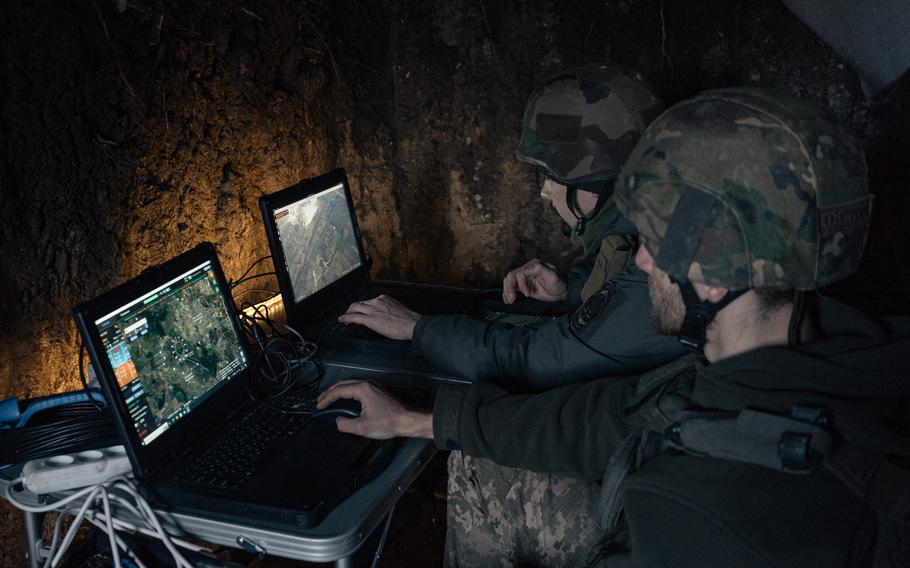
Ukrainian soldiers monitor footage from a reconnaissance drone from devices set up in a foxhole. (Alice Martins/The Washington Post)
Two seemingly contradictory things can be true at the same time. This is particularly true in warfare, which has a way of turning conventional wisdom upside down in the course of a battle.
If you had told me, a former supreme allied commander of NATO, that more than one-third of the combat ships in the Russian Black Sea fleet would have been sunk or severely damaged in just over two years of war — despite the fact that Ukraine has no functional navy — I would have been deeply skeptical.
Yet the Ukrainian armed forces have already taken the Black Sea fleet out of the game. The flagship of Russian President Vladimir Putin’s fleet, the guided missile cruiser Moskva, was sunk early in the war by a combination of exquisite intelligence and unmanned weapons.
Since then, Russia fired its top admiral and has been very cautious about moving its fleet close to the Ukrainian coast. Even still, Russian warships have continued to be damaged or sunk by Ukraine’s drones.
Does this spell the end of big surface warships? Yes, say many naval experts. Surface ships can seem like the big row of battleships sunk or grievously damaged during the attack on Pearl Harbor in December 1941. That moment signaled the ascendancy of the carrier Navy that dominated World War II in the Pacific and has continued since.
So why, it’s fair to ask, is warship construction booming? China is far outpacing the United States in construction of cruisers, destroyers and frigates. Beijing is also building carriers and starting to provide them with nuclear propulsion. China has more than 300 surface warships and is building an estimated 20 to 30 yearly. The United States — along with Japan, South Korea, India, Australia and many European navies — continues to build these platforms, too. In the face of drones and ever more sophisticated missiles, why would these navies keep building vulnerable surface warships?
The simple answer is: It’s not an either/or situation. Yes, militaries in general, and naval forces in particular, are undergoing a paradigm shift that will entail the use of more unmanned vehicles — satellite systems with attack capability, high-altitude, long-dwell sensors, large airborne drones akin to today’s Predators and Reapers; surface vehicles on the ocean’s waves moving at very high speed and packed with explosives; and smart torpedoes with long-range sensors and the ability to loiter undersea.
But all those unmanned systems don’t mean that surface ships are finished. We will need and must defend against both for some time.
First, unless and until we create massive underwater tankers and cargo ships to carry global trade, we will need surface navies to exercise control of vital sea lanes.
Global trade, without the benefit of escort ships, is just too vulnerable to attack. We cannot simply cede the world’s oceans to enemies and their relatively cheap unmanned weapons. Commercial vessels — some of them weighing in at hundreds of thousands of tons — must be escorted and protected by surface forces with guided missiles (and eventually drone-killing lasers). We are in the process of learning this lesson from the Houthi rebels attacking shipping in the Red Sea.
Secondly, great as our advantages are, the bad guys get smarter eventually. In the early months of the Ukraine war, western drone technology ruled the battlefield. But the Russians soon began to improve their electronic warfare capability, jamming and deactivating the communication links and guidance systems of many of the Ukrainian drones. This has happened before: When the Japanese ran out of ways to stop the steady approach of the U.S. Navy in World War II, they resorted to sending pilots in planes loaded with explosives directly at American surface ships.
The Navy initially had no effective defense against the kamikaze pilots and lost many ships and thousands of sailors to this new offensive capability, and as I note in my new book, “The Restless Wave: A Novel of the U.S. Navy,” Japan was able to use its new weapon until it ran out of planes and pilots.
Today’s surface warships, like the guided missile destroyer I commanded three decades ago, are very capable at shooting down incoming missiles with missiles of their own. But such weapons are costly and expended far more quickly in combat — the destroyers operating in the Red Sea typically have around 60 such antiaircraft missiles. And they can cost 10 times more than the drones they are shooting down.
The immediate answer is likely going to be lasers. If a ship has sufficient electric generation, there is plenty of power to knock down incoming weapons with lasers. When those lasers are guided by advanced phased array radars, they will tip the balance away from the drones and back toward the defenders.
So, yes, it is true that the variable dial of warfare is moving toward a far greater role for unmanned vehicles naval warfare. Yet it is also true that surface ships, while more vulnerable in this moment of transition, still have a significant offensive capability. The aggressive shipbuilding program of China continues, and the United States needs to accelerate its own. We will need both exceptional unmanned offensive systems — and we will still have to defend the surface of the sea.
Surface warships or drones? I’ll take some of each, please.
James Stavridis, a retired admiral and former supreme allied commander of NATO, is vice chair, global affairs, of the Carlyle Group and chair of the board of trustees at the Rockefeller Foundation.